| |
|
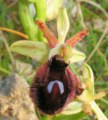 | |
| MaltaWildPlants.com by Stephen Mifsud |

|
| |
|
|
 |  |  |  |
| External Links: |
|
Silene vulgaris subsp. vulgaris (Bladder Campion) |

Silene vulgaris subsp. vulgaris (CARYOPHYLLACEAE.)
Images for this profile are taken from the Maltese Islands after year 2000. |
|
| Nomenclature |
Species name : | Silene vulgaris subsp. vulgaris (Moench) Garcke | Authority : | Conrad Moench, Germany, (1744 - 1805) ;
Christian August Friedrich Garcke, Germany, (1819 - 1904) | Synonyms :
(basionym or principal syn.) |
|
Plant Family : | Caryophyllaceae Juss.
(Pink or Carnation Family) | English name(s) : | Bladder Campion, Bird's Egg, Maiden's Tears | Maltese name(s) : | Qasqejża | Status for Malta : | Indigenous. Present on the Maltese islands before man | Name Derivation : |
Silene: "probably from the Greek ""sialon"" (=saliva) referring to the viscous excretion of several species. Another derivation could come from the name Silenus, the intoxicated foster-father of Bacchus (god of wine) who was covered with foam, much like the glandular secretions of many species of this genus". (Greek origin ); 2 = probably from the Greek "sialon" (=saliva) referring to the gummy exudation on the stems. Another derivation could come from the name Silenus, the intoxicated foster-father of Bacchus (god of wine) who was covered with foam, much like the glandular secretions of many species of this Genus (Latin);.
vulgaris subsp. vulgaris: 1 = Common (Latin).
| Remarks : | |
|
| Morphology and structure |
PLANT STRUCTURE: |
Character | Growth Form | Branching | Surface |
Description | | | |
General
Picture |  |  | 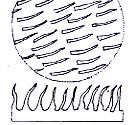 |
|
LEAVES: |
Character | Arrangement | Attachment | Venation |
Description | | | |
General
Picture |  |  |  |
| |
Character | Leaf Shape | Leaf Margin | Remarks |
Description | | | |
General
Picture |  |  |  |
|
FLOWERS: |
Character | Colour | Basic Flower Type | No. of Petals | No. of Sepals |
Description | WHITE | | 5 | 5 (1 fused unit) Sepals are fused as one single cup-shaped structure with 5 apical lobes. |
General
Picture | | 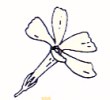 |  |  |
| |
Character | Inflorescence | Description | Ovary | Stamens |
Description | | Flower consists of 5 white petals each having a deep indentation that splits the petal into two distinct bodies and makes the flower look as if it has 10 petals. The calyx is prominent, having an inflated balloon shape with toothed mouth from which the 5 stamens, and 3 longer styles protrudes out. | | |
General
Picture | 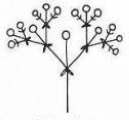 |  | 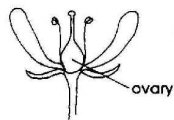 | 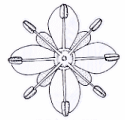 |
| |
Character | Scent | Average Flower Size | Pollen Colour | Other Notes |
Description | Mild A slightly unpleasant scent is sometimes given off. | 22mm | Yellow or White | - |
|
SEEDS: |
Character | No. Per Fruit | Shape | Size | Colour |
Description | 1-50 Number of seeds is very variable from one fruit to another. | Reniform Kidney or bean-shaped structure with a rough texture. | 2-3mm | Light Brown |
General
Picture |  |  |  |  |
|
FRUIT AND OTHER BOTANICAL DATA: |
Character | Fruit Type | Colour of Fruit | Subterranean Parts | Other Notes |
Description | | Beige-Grey (The ovary is completely covered by the vase-like calyx). | | - |
General
Picture |  |  |  |  |
|
|
| Plant description and characters | |
Life Cycle: | Perennial. |
Growth Form: | HEMICRYPTOPHYTE (prostate plants with flowers close to the ground) |
Habitat: | Lanes along countryside, walls, cultivated and fallow land, and valley sides. |
Frequency: | Scarce |
Localities in Malta: | Fairy common. Located at Dingli (Villa Psaigon area), fields at Wied Babu (Zurrieq), Bahrija and also seen at the valley sides of Xlendi (Gozo). |
Plant Height: | Up to 60cm. |
| Jan-May |
Protection in Malta: | Not legally protected till the last update of this website (2/Mar/2022) |
Red List 1989: | Not listed in the Red Data Book of the Maltese Islands |
Poison: | |
This plant is not common in Malta as much as the sericea species. It is an erect perennial which can grow from loose chalky soil patches and sometimes also from walls. It flowers in late spring and does not grow much more from 50-60cm. The stem is glabrous and makes few branches.
The leaves are opposite and usually decussate (opposite pairs at right angles with the ones above or below). With exception of the basal leaves, they are generally stemless. The leaf is quite simple, having a linear/ovoid shape with a tapering apex, and an entire outline. Leaves are hairless, and have a smooth silky texture.
Although it forms part of the Pink family (Caryophyllaceae) the flowers are white. They are made up of 5 petals each having a deep indentation. This splits the petal in two distinct lobules (parts), and hence the 5 petals may seem to count as 10 petals by the observer. There are 10 stamens, growing from the base of every petal. The filaments are usually green but they can be pink or purple in colour. The anthers can be green, black or yellow in colour, but the pollen ridges are usually always light yellow or white. Often, the stamens have unequal length and not arranged radially symmetrical around the center of the flower. The 3, hair-thin styles possess feathery stigmas and are longer than the stamens. They grow from the central ovary at the base of the flower.
Perhaps the most eye-catching part of the plant is the calyx rather than the flower. It is a large inflated structure, pale green or green yellow in colour and have the shape of a balloon or bladder (hence its name Bladder campion). The mouth of the calyx have a 5-toothed rim looking like a crown. When the flower dies, the calyx the anthers withers but persists and do not fall out. The whole structure makes it look like a bit weird (a bowl with serpents)! With time, the calyx gets brown, but maintains its inflated bladder shape, where it covers and protects the developing seed capsule inside.
The seeds are kidney shaped and have a rough and have a very interesting texture when observed with a magnifying glass.
|
|
| Information, uses and other details |
Habitat
The plant can be found in weedy places, in semi-dry turf, and open dry places. it likes warm, nitrogenous, and rather calcareous (rich in Calcium / lime) [272] Maybe that's why it is found growing in the drying months of May and June in Malta. [SM]
Poison
Although no mention of toxicity has been seen for this species, it does contain saponins. Although toxic, these substances are very poorly absorbed by the body and so tend to pass through without causing harm. They are also broken down by thorough cooking. Saponins are found in many plants, including several that are often used for food, such as certain beans. It is advisable not to eat large quantities of food that contain saponins. Saponins are much more toxic to some creatures, such as fish, and hunting tribes have traditionally put large quantities of them in streams, lakes etc in order to stupefy or kill the fish [KF].
More info about saponin can be found in the links section (click here)
Sexual characteristics of the plant
According to [JS], Silene vulgaris is gynodioecious - having hermaphrodites and female flowers. Hermaphrodites are protandrous. Few plants both in the greenhouse and in the wild (in eastern north america) have been observed by [JS] of having hermaphrodite and female flowers on the same plant, hence it is believe this is one type of gynomonecy. Additionally, he noticed that anthers usually dehisce in the evening and the plant is self-fertile. Geitonogamous selfing can be important, particularly in small populations where outcross pollen is unavailable. Although self-fertile, temporal seperation of male and female phases (protandry) promotes outcrossing.
On the other hand, [KF] states that the flowers are dioecious - individual flowers are either male or female, and only one sex is to be found on any one plant. Hence both male and female plants must be grown if seed is required. They are pollinated by Lepidoptera (Moths & Butterflies) and bees. The plant is usually not self-fertile.
How to identify if flower is sex or male?? If flower has large style and stigmas higher from stamens (which may even be absent), then it is a female. If it has large anthers and small or absent styles it is male. For example, in this picture , right top flower is female (3 styles) where as the one below is male (5 anthers).
Edible Uses
Young shoots and leaves - raw or cooked [2, 5, 8, 9, 52]. The young leaves are sweet and very agreeable in salads [217]. The cooked young shoots, harvested when about 5cm long, have a flavour similar to green peas but with a slight bitterness [183]. This bitterness can be reduced by blanching the shoots as they appear from the ground [183]. When pureed it is said to rival the best spinach purees [183]. The leaves can also be finely chopped and added to salads [183]. The leaves should be used before the plant starts to flower [9].
Medicinal Uses
The plant is said to be emollient (Ointments, creams, lotions etc., used for softening, soothing and moisturising inflamed or dry skin. [271]) and is used in baths or as a fumigant [240].
The juice of the plant is used in the treatment of ophthalmia [240] - (Opthalmia = certain types of inflammation of the conjunctiva [241]).
Other Uses
Although no specific mention has been seen for this species, it is most likely that the root is used as a soap substitute for washing clothes etc [46, 61, 272]. The soap is obtained by simmering the root in hot water which releases the soaping agent - Saponin.
The Bladder Campion secretes abundant nectar in its flowers which attracts butterflies but mostly moths. [13, 272] Moths are the main insects for pollinating this plant. It has been used to attract moths or prepare moth food.
Personal Observations
The prominent, inflated, light brown / pale yellow-green calyx was more eye-catching than the white flower itself. The corolla withers and falls off but the calyx remains alive for some days and so there would be more calyces then blooming flowers per plant. [SM]
The general view of the fruit is a bit weird too. The calyx resembles a pot, and the remaining dried stamens + styles protruding out looks like serpents or worms coming out from the pot. [SM]
The flowers are white although they come from a plant family called the PINK family. The only signs of pink can be noted in anthers or the filaments. [SM]
Many flowers gives the impression that the petals are not symmetrically arranged. Some petals are more distant from one neighbouring petal than to the other one. Also the lower petal(s) are somehow larger than those above. Radialy symmetry is not perfect sometimes. [SM]
|
|
| Links & Further literature
(0 papers) |

Google Web |

Google Images |

Google Scholar |

Research Gate |

Wikipedia |

JSTOR |

GBIF |

Med Checklist |

Cat. of Life |

EoL |

IPNI |

World Flora Online |

Plants of the World Online |

Vienna Virt. Herb. |

RBGE Herbarium |

KEW Herbarium |

MNHN |

Arkive |

IUCN |

CABI |
Kindly Email if there are papers and publications about local
studies or information about this species to be included in the list above.
|
| Photo Gallery (36 Images) |  |
 |
 |
 |
IMAGE: SILVU-01 Photo of flower with its conspicuous and characteristic inflated, balloon-shaped calyx. |
IMAGE: SILVU-02 Photo of flower which has 5 petals each divided into 2 parts, giving the false impression that the flower has 10 petals. |
IMAGE: SILVU-03 Close up photo of flower showing the 10 stamens which have unequal length. 5 stamens are well protruded out, while another 5 are at or inside the mouth of the flower. |
IMAGE: SILVU-04 Lateral view of photo showing the large, inflated calyx. This varies in colour from grayish-green to pale purple-brown. |
 |
 |
 |
 |
IMAGE: SILVU-05 Photo of lateral view of flower showing its characteristic inflated calyx, for which the common name - bladder catchfly - is given to this plant. |
IMAGE: SILVU-06 Photo of flower having 5 white petals each divided into 2 deep lobes. |
IMAGE: SILVU-07 Photo of flower with its 10 stamens and 3 long white styles. |
IMAGE: SILVU-08 Photo of flower showing the 'un-ordered' arrangement of the stamens having an unequal length. The styles are white and short-haired. |
 |
|  |
 |
IMAGE: SILVU-09 Photo of flower (side view) showing the calyx with triangular lobes at the mouth. |
IMAGE: SILVU-10 - |
IMAGE: SILVU-11 Close up photo of flowers showing in detail 5 of the 10 stamens. The other 5 stamens lie inside the flower. |
IMAGE: SILVU-12 Photo showing the mouth of the calyx, and the 3 long styles with pale-purple tipped stigma. |
 |
 |
 |
 |
IMAGE: SILVU-13 Close-up image of the white stigma and club-shaped style. Note the tiny hair. |
IMAGE: SILVU-14 Image of the calyx which has longitudinal vains, cross linked by secondary net-like veins. This species has about 20 veins, other species are distinguished by having 10 longitudinal veins or 30 (E.g. Silene conica). |
IMAGE: SILVU-15 Photo showing well the network of veins in the calyx. |
IMAGE: SILVU-16 Scanned and annotated image of flower against a dark background. |
 |
 |
 |
 |
IMAGE: SILVU-17 Photo of inflorescences growing out from 2 opposite leaves (or leaf-like bracts). |
IMAGE: SILVU-18 Photo of inflorescence of plant which consists of diverging flowering branches with a flower peduncle (stem) in the middle. The middle flower is the one which blossoms first. This arrangement is known as a dichasium. |
IMAGE: SILVU-19 Photo of inflorescences showing clearly the dichasium chyme type of arrangement, where the middle flower being the first to open in any flower branch. |
IMAGE: SILVU-20 Photo of buds which are well conspicuous thanks to the large, net-veined, inflated calyces. |
 |
 |
 |
| IMAGE: SILVU-21 Scanned image of flowering dichasium cyme. Also seen are the tiny bracts. |
IMAGE: SILVU-22 Scanned image of a longitudinally dissected flower to show arrangement of inner reproductive organs. Note the superior, spherical, purple-brown ovary. | .
IMAGE: SILVU-23 Scanned image of 2 dissected petals against a dark background. Each petal is split in two distinct petal-lobes and has 2 stamens joined to its base (one of the stamen is removed). |
IMAGE: SILVU-24 - |
 |
 |
 |
 |
IMAGE: SILVU-25 Photo of a large population with bright green, oval-lanceolate leaves. They are arranged opposite to each other, where the row of opposite leaves are at right angles with the one below or above. Such an arrangement of leaves is additionally referred to as opposite decussate arrangement. |
IMAGE: SILVU-26 Photo of leaves, spathulate or ovate-lanceolate. The subspecies angustifolia, also present in Malta, has narrower leaves, that is, linear-lanceolate, and often they are darker in colour and more fleshy. |
IMAGE: SILVU-27 Photo of leaves of Silene vulgaris subsp. vulgaris. Sessile and decussate. |
IMAGE: SILVU-28 Photo of leaves against sunlight. They have a linear or oblanceolate shape and do not have conspicuous veins except the central midrib. |
 |
| |  |
IMAGE: SILVU-29 Photo of a large plant with many leaves and its early flowers (Taken in January 2005). |
IMAGE: SILVU-30 - |
IMAGE: SILVU-31 - |
IMAGE: SILVU-32 Colour illustration of the plant and its parts taken from Flora Danica Online. |
 |
 |
 |
 |
IMAGE: SILVU-33 Photo of seedling. |
IMAGE: SILVU-34 Photo of fruit after removing part of the calyx in which it is covered. The fruit is pear-shaped and sits on a cylindrical, cushion-like structure called the carpophore. |
IMAGE: SILVU-35 Photo of immature fruit which later becomes an indehiscent capsule, that is, a capsule that does not break open to shed seed, but these escape from an opening. |
IMAGE: SILVU-36 Glabrous seed-pod covered by the papery, dried calyx. Parts of the calyx were removed or folded to reveal the seedpod. |
 |
 |
 |
| IMAGE: SILVU-37 Cross section of seedpods. They are divided into 3 longitudinal chambers (locules). |
IMAGE: SILVU-38 Magnified scanned image of the brown seeds which are kidney shaped and have many pointed projections. |
IMAGE: SILVU-39 Magnified image of seeds under light microscope. |
IMAGE: SILVU-40 |
|
| | |

